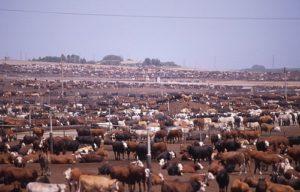No sooner had March begun than news spread about the rise of a new “superbug” that kills about half of all who contract it through bloodstream infections. Microbes like this one – called Carbapenem-Resistant Enterobacteriaceae, or “CRE” for short – are one result of the overuse and misuse of antibiotics.
And it’s not just about those that come from the doctor’s or dental office. Four-fifths of all antibiotics in the US are given to livestock – nearly 30 million pounds a year. (Sales for human use are less than 8 million pounds.)
This means that if you eat foods derived from conventionally raised animals – meat, eggs, dairy – you may be getting a bit of a dose, as well.
 “Conventional” means factory farms, known in the agribusiness world as Animal Feeding Operations, or AFOs. Animals are confined for at least 45 days a year without grass or other vegetation. Fifteen percent of these are Concentrated Animal Feeding Operations, or CAFOs. Here in Texas, a large beef CAFO is defined as having 1000 or more head of cattle. (Regulations specify for all manner of livestock – 10,000 or more swine, for instance, or 125,000+ chickens and so on.)
“Conventional” means factory farms, known in the agribusiness world as Animal Feeding Operations, or AFOs. Animals are confined for at least 45 days a year without grass or other vegetation. Fifteen percent of these are Concentrated Animal Feeding Operations, or CAFOs. Here in Texas, a large beef CAFO is defined as having 1000 or more head of cattle. (Regulations specify for all manner of livestock – 10,000 or more swine, for instance, or 125,000+ chickens and so on.)
Such crowded, stressful and unhealthy conditions justify the prophylactic use of antibiotics just to keep animals alive. But the drugs also promote faster growth, resulting in quicker, higher profits.
Meantime, we – and our environment – pay the price.
Your best bet to deal with these problems? Go vegan or make the move to buying local, organic and sustainably raised meat, dairy and eggs. Either is better for the environment and better for you and your health.
Previously: Why Organic Food Matters (& How to Find It Close to Home)
Image by Socially Responsible Agricultural Project, via Flickr